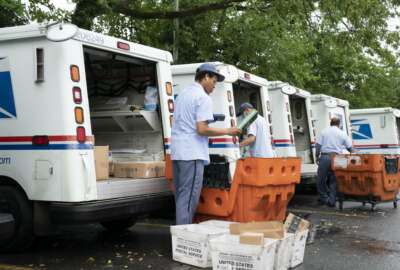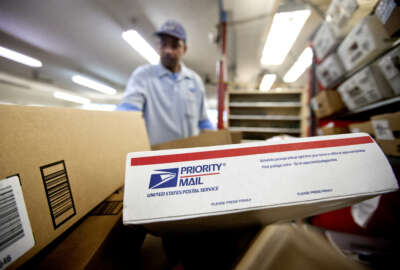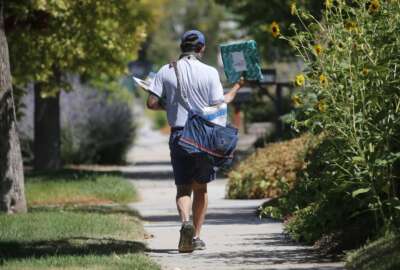USPS ends peak holiday surcharge as it cuts year-end demand for temporary hires
The Postal Service is looking to cut costs by building up its career workforce and hiring far fewer temporary, seasonal employees to prepare for the year-end...
The Postal Service is looking to cut costs by building up its career workforce and hiring far fewer temporary, seasonal employees to prepare for the year-end holiday season.
USPS is now passing those savings onto its customers, in the hopes that lower prices will help the agency capture a bigger share of a competitive package business.
Postmaster General Louis DeJoy told reporters Tuesday that USPS will forgo a holiday surcharge that the agency added to its peak season in recent years.
DeJoy said USPS isn’t adding the surcharge this year, because “we’ve made a lot of operational improvements that eliminated some of the extra activities that we had when I first got here.”
Those operational improvements include growth in its career workforce — with better pay and benefits than its pre-career workforce — and the addition of new sorting machines that have more than doubled the volume of packages USPS can deliver during the holidays.
DeJoy said USPS added a surcharge in recent years to reflect higher year-end workforce costs, particularly when the agency faced significant staffing shortages at the height of the COVID-19 pandemic.
“Prior to me being here, we never had an incremental charge,” DeJoy said. “We put it in, because in my experience in the commercial business, when you have to do such exponential, extra work, you should, in fact, charge for it — and we did.”
USPS is relying less on seasonal hiring, after building up its career workforce over the past few years.
Since January 2021, USPS converted 150,000 of its pre-career employees to career positions “bringing both stability and energy from our workforce to succeed in our mission,” DeJoy said.
The agency is only looking to hire 10,000 seasonal employees nationwide. USPS started to significantly taper its seasonal hiring last year, when it brought 20,000 temporary hires onboard.
USPS Chief Retail and Delivery Officer Joshua Colin said USPS is looking to hire rural letter carriers, post office clerks and mail processing plant employees.
“Our continued focus is on retaining the employees that sign up and come on board, and making sure they have a great employee experience, so they stay with us,” Colin said. “Know with confidence that your package will be delivered by a trusted postal carrier who knows the customer on their route.”
Jakki Krage Strako, USPS executive vice president and chief commerce and business solutions officer, said the agency, prior to this new seasonal workforce strategy, would hire tens of thousands of temporary employees each year to meet its holiday season demand.
“Because we’ve done the employee conversions, since we’ve made investments, the number of people we’re going to need to bring on extra this holiday season has decreased dramatically,” Strako said. “If we’re not going to incur a hyper-expense, like we have in past seasons, we had the opportunity to make sure that we were not charging the demand fees, as our competitors call it.”
USPS, she added, expects lower rates will give the agency a “key competitive advantage” winning over a greater share of the holiday package business from private-sector shippers like UPS and FedEx
DeJoy said USPS is building on a new strategy to prepare for the holiday season, one that’s worked well over the past two years. In 2020, before USPS released its 10-year reform plan, he said the agency was ill-equipped to handle demand and saw unacceptable delays in delivery.
“We were short on trained people, short on space, short on package processing equipment, short on operating precision, short on effective transportation and short on acceptable service,” DeJoy said. “Over the last two years, we have made remarkable improvements to our operations, as demonstrated by the two successful peak seasons we had in 2021 and 2022.”
DeJoy said USPS is now seeing far fewer calls and complaints about deliveries than it did in 2020 — about a 70% decrease, by some measures.
“If you look at 2020, the number of calls was probably three times as many as we’ve seen in the last two years. Each call is not necessarily a complaint. It’s ‘Where’s my package?’ And ‘Where’s my package’ can start before we even have been tendered the package. But in any case, all of those have come down significantly.”
However, it remains unclear if USPS will see a higher package volume than last year’s peak season.
“That would be a prediction I do not want to make, but I pray for it,” DeJoy said. “We’ve seen our volume really start to pick up [and] run ahead of last year’s demand. I don’t suspect it would be much more, because last year was a pretty decent amount of volume, but I think we can run ahead.”
“Long-term, I’m very confident we will see an increase in volume. How it reflects in peak. I’m hopeful that we see more and more volume, but we will operate more precisely and more cost-effectively this peak,” he added.
Copyright © 2025 Federal News Network. All rights reserved. This website is not intended for users located within the European Economic Area.
Jory Heckman is a reporter at Federal News Network covering U.S. Postal Service, IRS, big data and technology issues.
Follow @jheckmanWFED






